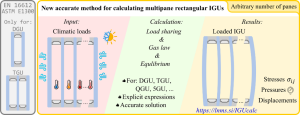The researchers from the Laboratory for Numerical Modeling and Simulations in Mechanics (LNMS), in collaboration with Reflex d.o.o. and the Faculty of Mathematics and Physics, have developed a method for calculating the mechanical response of multi-layer glazing under climatic loads. The developed method has been published in the prestigious Journal of Building Engineering (IF: 6.4).

Multi-layer glazing finds applications in window and facade elements. As the number of glass layers increases, the thermal insulation of the glazing improves, enhancing the comfort of living in the building. However, an increase in the number of panes also amplifies the impact of climatic loads on the mechanical structure. The gas chambers’ insulation hinders the dissipation of accumulated heat from solar radiation, leading to pressure increase in the chambers and increased loads on individual glass panes.
While European standard EN 16612 and American standard ASTM E1300 allow for mechanical calculations of glazing structures, they are limited to two- and three-layer glazing and do not cover structures with a larger number of glass layers. A detailed analysis of these standards revealed that, even for a small number of glass layers, the standards do not provide accurate calculations due to employed simplifications.
In this study, the researchers have developed a new method that is not only more accurate and elegant than the two standardized methods but also allows for mechanical calculations for arbitrary number of panes in the glazing. The formulation also facilitates easy updating and upgrading of the established standard EN 16612.
The entire article is available on the website: https://doi.org/10.1016/j.jobe.2023.107955
